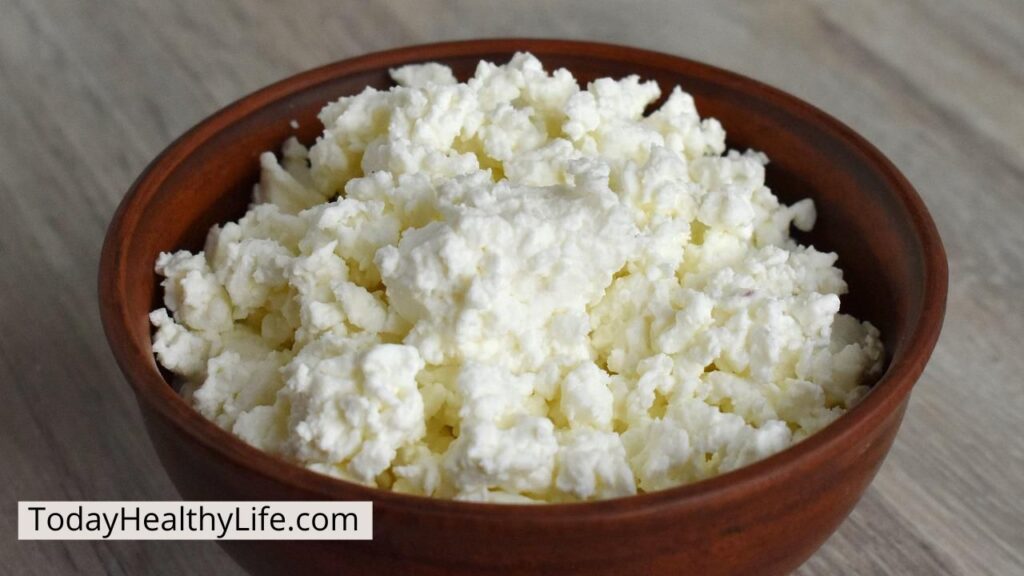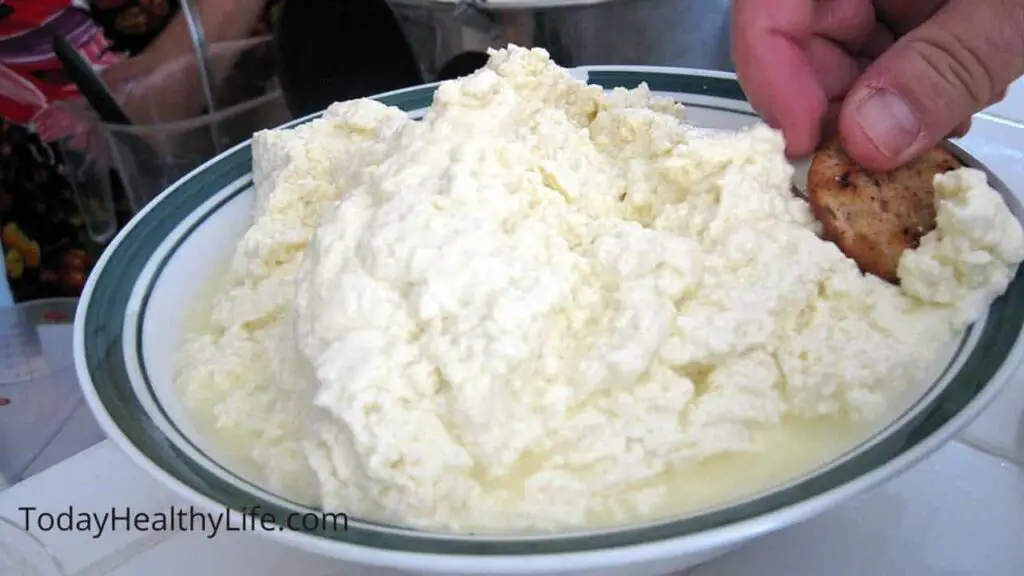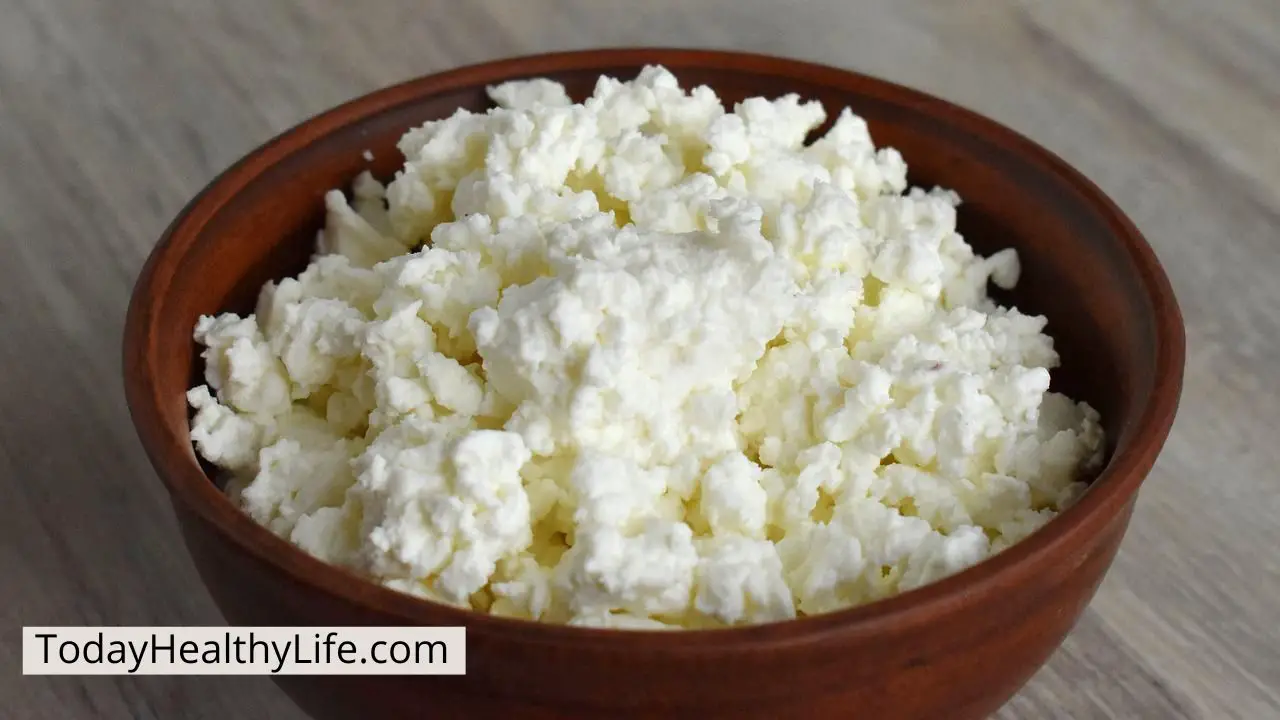If you didn’t try cottage cheese yet then you might wonder, “what does cottage cheese taste like”?
Is there anything more quintessentially American than cottage cheese? This humble dairy product has been a staple of the American diet for generations, but what does it actually taste like? And is it still worth eating in the age of alternative protein sources?
Read on to find out.

Table of Contents
What is cottage cheese?
Cottage cheese is a fresh, unripened cheese that is made from curdled milk. It is a soft, white cheese with a mild flavor and a creamy, heterogeneous, soupy texture.
Cottage cheese is made from skimmed milk by draining curds but retaining some of the whey and keeping the curds loose.
An essential step in the manufacturing process distinguishing cottage cheese from other fresh cheeses is the addition of a “dressing” to the curd grains, usually cream, which is mainly responsible for the taste of the product
Types of cottage cheese:
There are a few different types of cottage cheese available, which mainly differ based on their fat content.
Here are some common types:
- Regular Cottage Cheese: This is the standard version of cottage cheese and is usually made from whole milk. It has a higher fat content and a richer flavor compared to other varieties.
- Low-Fat Cottage Cheese: As the name suggests, this type of cottage cheese has a reduced fat content. It is made from skimmed or partially skimmed milk, resulting in a lighter texture and fewer calories.
- Non-Fat or Fat-Free Cottage Cheese: This type of cottage cheese is made from skimmed milk, containing virtually no fat. It is the lowest in calories and fat among cottage cheese varieties. However, it may have a slightly less creamy texture compared to higher fat options.
- Small-Curd Cottage Cheese: Cottage cheese can also be categorized based on the curd size. Small-curd cottage cheese has smaller curds, resulting in a smoother texture.
- Large-Curd Cottage Cheese: Large-curd cottage cheese has larger curds, giving it a more textured and chunky consistency.
- Flavored Cottage Cheese: Some cottage cheese varieties come in different flavors, such as pineapple, strawberry, chive, or herbs. These flavored options add additional taste and variety to the plain cottage cheese.
It’s important to note that the availability of these types may vary based on your location and the specific brand or manufacturer.
Flavor:
Some common flavored cottage cheese varieties include:
- Fruit Flavors: Cottage cheese is often combined with fruits like pineapple, strawberry, blueberry, peach, or mango to provide a sweet and fruity twist.
- Savory Flavors: Cottage cheese can also be flavored with herbs and spices like chives, dill, garlic, onion, or black pepper. These variations add a savory and aromatic touch to the cheese.
- Sweetened or Vanilla Flavors: Some cottage cheese products come with added sweeteners or vanilla flavoring, giving them a sweeter taste that can resemble a dessert or be used in dessert recipes.
- Spicy Flavors: Cottage cheese can be infused with spices like jalapeno, chili, or other hot peppers to provide a spicy kick.
These flavored options allow for a wider range of taste preferences and can be enjoyed on their own or used as ingredients in recipes.
It’s worth noting that the availability of flavored cottage cheese may vary based on the brand and location.
Texture:
The texture of cottage cheese is characterized by its lumpy and curdy consistency. The curds in cottage cheese are relatively large and soft, giving it a unique texture compared to other types of cheese.
The curds are typically moist and slightly creamy, with a bit of a crumbly or grainy feel.
The texture of cottage cheese can vary depending on factors such as the type of milk used (whole milk, skimmed milk, etc.), the curd size (small or large), and the manufacturing process.
Cottage cheese made from whole milk tends to have a creamier texture, while lower-fat or non-fat versions may have a lighter and less creamy texture.
Additionally, cottage cheese can have different levels of moisture content. Some varieties may be more moist, while others can be drier, depending on the manufacturing process and personal preferences.
Overall, the texture of cottage cheese is characterized by its curds that are soft, lumpy, and slightly crumbly, providing a unique mouthfeel that distinguishes it from other types of cheese.
Uses:
Cottage cheese is a versatile ingredient that can be used in various ways. Here are some common uses of cottage cheese:
- Eating It on Its Own: Cottage cheese can be enjoyed as a standalone snack or meal. It can be eaten plain or seasoned with salt, pepper, herbs, or spices according to personal taste preferences.
- Salad Topping: Cottage cheese can be used as a protein-rich topping for salads. It adds a creamy and tangy element to the salad, enhancing both the texture and flavor.
- Sandwich or Wrap Filling: Cottage cheese can be spread on bread or used as a filling in sandwiches, wraps, or pitas. It adds a creamy and nutritious component to the sandwich while complementing other ingredients like vegetables, meats, or spreads.
- Baking and Cooking: Cottage cheese can be used as an ingredient in various recipes. It can be added to baked goods like pancakes, muffins, or cheesecakes to provide moisture and a creamy texture. Cottage cheese can also be used in casseroles, pasta dishes, and sauces to enhance the creaminess and protein content.
- Dip and Spread: Cottage cheese can be blended with herbs, spices, or other ingredients to create flavorful dips and spreads. It can be used as a base for vegetable dips, served with crackers or vegetable sticks, or spread on toast or bagels.
- Smoothies and Shakes: Cottage cheese can be added to smoothies or protein shakes to increase the protein content and create a creamy texture. It pairs well with fruits, yogurt, and other smoothie ingredients.
These are just a few examples, but the uses of cottage cheese are not limited to these. Its versatility allows for creativity in incorporating it into various recipes and dishes based on personal preferences and dietary needs.
What does cottage cheese taste like?
Cottage cheese has a mild and slightly tangy flavor. The taste is often described as creamy, with a hint of saltiness.
The tanginess comes from the natural fermentation process that occurs during the production of cottage cheese.
The flavor of cottage cheese is not overpowering, making it a versatile ingredient that can easily be paired with other foods.
The taste can vary slightly depending on factors such as the fat content (regular, low-fat, non-fat), the specific brand or manufacturer, and any added flavors or seasonings.
While cottage cheese does have its own unique taste, it is relatively neutral compared to stronger or aged cheeses.
This mild flavor allows cottage cheese to be enjoyed on its own or easily incorporated into both sweet and savory dishes, where it can enhance other flavors without dominating the overall taste.
Also Read:
- Can You Freeze Cottage Cheese? (Risk, Guidelines & All).
- Can You Freeze Ricotta Cheese? (Side Effects, Benefits & All).
- How Long Can Yogurt Sit Out? -At Room Temperature, Tips & All.
- Is Ricotta Cheese Gluten-Free? Gluten-Free Brand, Risk & More.
- What Does Dragon Fruit Taste Like? Side Effects, Recipes & All.
Does cottage cheese taste good?
Whether or not cottage cheese tastes good is a matter of personal preference. Some people love the tangy flavor and creamy texture, while others find it to be too bland or sour.
If you’ve never tried cottage cheese before, we recommend giving it a taste test to see if you like it. Many people enjoy eating cottage cheese as a snack, on top of a salad, or as an ingredient in recipes.
If you’re not sure where to start, we recommend trying a small curd cottage cheese with some fruit or a large curd cottage cheese with a savory topping.
Why does cottage cheese taste so bad?
Cottage cheese has a distinct taste that some people find unpleasant. As we mentioned before, the taste of cottage cheese is often described as sour, salty, or tangy.
Some people also find the texture to be off-putting.
If you don’t like the taste of cottage cheese, you can try adding flavorings like fruit or honey to make it more palatable. You can also look for cottage cheese recipes that include other ingredients to mask the taste.
What does cottage cheese smell like?
Cottage cheese has a distinct smell too that some people find unpleasant. The smell of cottage cheese also is often described as sour, salty, or tangy.
Some people also find the texture to be off-putting. If you don’t like the smell of cottage cheese, as we mentioned you can try adding flavorings like fruit or honey to make it more palatable.
You can also look for cottage cheese recipes that include other ingredients to mask the smell. Keep reading for the recipe.
What is the process of making cottage cheese? Step by step.
Here are the steps on how to make cottage cheese:
- Heat the milk. Heat the milk to 86°F (30°C).
- Add the culture. Add the lactic acid culture to the milk. The culture will help to acidify the milk and cause the curds to form.
- Add the rennet. Add the rennet to the milk. The rennet will cause the milk to coagulate and form curds.
- Cut the curds. Cut the curds into small cubes using a curd knife. This will help to release the whey from the curds.
- Heat the curds. Heat the curds to 115°F (46°C). This will help to further release the whey from the curds.
- Drain the whey. Drain the whey from the curds. This can be done using a colander or a cheesecloth-lined strainer.
- Rinse the curds. Rinse the curds with cold water. This will help to remove any remaining whey and salt the curds.
- Package the curds. Package the curds in a container and refrigerate.
Here are some additional tips for making cottage cheese:
- The type of milk you use will affect the taste and texture of the cottage cheese. Whole milk will give you a richer, creamier cottage cheese, while skim milk will give you a lighter, more tart cottage cheese.
- The amount of culture you use will affect the acidity of the cottage cheese. A higher acid content will give you a firmer, more curdled cottage cheese, while a lower acid content will give you a softer, more spreadable cottage cheese.
- The amount of rennet you use will affect the firmness of the curds. A higher amount of rennet will give you firmer curds, while a lower amount of rennet will give you softer curds.
- The temperature of the milk will affect the speed at which the curds form. A warmer temperature will cause the curds to form more quickly, while a cooler temperature will cause the curds to form more slowly.
Cottage cheese is delicious and nutritious food that can be enjoyed in many different ways. By following these tips, you can make a delicious and healthy cottage cheese recipe that the whole family will enjoy.
All the nutrition facts about cottage cheese:
Here is a general nutrition table for a single serving of cottage cheese, which is typically considered to be around 4 ounces (113 grams):
| Nutrient | Amount | % Daily Value (DV) |
|---|---|---|
| Calories | 116 | 6% |
| Total Fat | 1.3 g | 2% |
| Saturated Fat | 0.7 g | 4% |
| Polyunsaturated Fat | 0 g | 0% |
| Monounsaturated Fat | 0.3 g | 1% |
| Cholesterol | 4.5 mg | 2% |
| Sodium | 459 mg | 20% |
| Total Carbohydrates | 3.1 g | 1% |
| Dietary Fiber | 0 g | 0% |
| Sugars | 3.1 g | 0% |
| Protein | 14 g | 28% |
| Calcium | 176 mg | 18% |
| Phosphorus | 126 mg | 13% |
| Potassium | 97.2 mg | 2% |
| Vitamin D | 0 mcg | 0% |
| Iron | 0.2 mg | 1% |
As you can see, cottage cheese is a good source of protein, calcium, and phosphorus.
It is also a good source of other nutrients, such as potassium and vitamin D.
Health benefits of cottage cheese one by one:
Cottage cheese is a nutritious food that offers many health benefits. It’s a good source of protein, calcium, phosphorus, selenium, vitamin B12, potassium, and riboflavin.
Cottage cheese is also a good source of probiotics, making it beneficial for gut health.
Including cottage cheese in your diet is a great way to get these nutrients and enjoy the many health benefits they offer.
1. Good source of protein.
Protein is an essential nutrient that helps to build and repair tissues, produce enzymes and hormones, and maintain fluid balance in the body.
Getting enough protein is especially important for athletes, pregnant women, and young children.
2. Low in calories.
If you’re watching your weight, cottage cheese is a great food to include in your diet. One cup of cottage cheese contains only 163 calories, making it a lower-calorie option than other cheeses.
3. Good source of calcium.
Calcium is an important mineral that helps to build and maintain strong bones and teeth. It’s also necessary for proper muscle function and blood clotting.
4. Good source of phosphorus.
Phosphorus is another mineral that is essential for bone health. It also helps the body to use carbohydrates and fats for energy, and aids in the repair of cell and tissue damage.
5. Good source of selenium.
Selenium is a trace element that acts as an antioxidant and plays a role in the immune system. Getting enough selenium is important for preventing cell damage and protecting against illness and infection.
6. Good source of vitamin B12.
Vitamin B12 is a water-soluble vitamin that is necessary for proper red blood cell formation, neurological function, and DNA synthesis.
It can be found naturally in animal foods like meat, poultry, eggs, and dairy products.
7. Good source of potassium.
Potassium is a mineral that helps to regulate blood pressure and fluid balance in the body. It’s also necessary for proper muscle function and heart health.
8. Good source of riboflavin.
Riboflavin is a water-soluble vitamin that acts as an antioxidant and plays a role in energy metabolism. It can be found naturally in eggs, milk, and other dairy products.
9. Good source of probiotics.
Probiotics are live microorganisms that provide health benefits when consumed. They’re often called “good” or “friendly” bacteria because they help to keep the gut healthy.
Cottage cheese is a good source of probiotics, making it beneficial for gut health.
How to tell if cottage cheese is spoiled?
Like all dairy products, cottage cheese can spoil if it’s not stored properly. Here are some signs that cottage cheese has gone bad:
- The cottage cheese is lumpy or has watery whey on top.
- The cottage cheese has an off smell.
- The cottage cheese has a sour taste.
If you notice any of these signs, cottage cheese should be discarded. Spoiled cottage cheese can cause food poisoning, so it’s important to be cautious when consuming it.
Side effects of cottage cheese
While cottage cheese is a healthy and nutritious food, there are some potential side effects to be aware of. Here are some possible side effects of cottage cheese:
Allergic reactions.
Some people may be allergic to cottage cheese. If you’re allergic to dairy products, you should avoid cottage cheese.
Digestive issues.
Eating large amounts of cottage cheese can cause digestive issues like gas, bloating, and diarrhea. If you’re prone to digestive problems, eat cottage cheese in moderation.
Lactose intolerance.
Cottage cheese contains lactose, which is a type of sugar that some people have trouble digesting. If you’re lactose intolerant, eat cottage cheese in moderation or choose a lactose-free variety.
Cottage cheese is a healthy and nutritious food, but there are some potential side effects to be aware of. If you’re concerned about any of these side effects, talk to your doctor before consuming cottage cheese.
Is cottage cheese good for weight loss?
Cottage cheese is a good source of protein and calcium, which can help with weight loss.
It’s also low in calories and fat, making it a good choice for people trying to lose weight.
However, cottage cheese is high in sodium, so it’s important to choose a low-sodium variety if you’re watching your salt intake.
What is the difference between cottage cheese and ricotta?

Cottage cheese and ricotta are both fresh cheeses made from milk, but they have some key differences.
- Texture: Cottage cheese has a lumpy, grainy texture due to the larger curds. Ricotta, on the other hand, has a smoother, creamier texture due to the smaller curds.
- Flavor: Cottage cheese has a mild, slightly acidic flavor. Ricotta has a sweeter flavor, with a hint of nuttiness.
- Nutrition: Cottage cheese is a good source of protein and calcium. Ricotta is also a good source of protein and calcium, but it has slightly more fat and calories than cottage cheese.
- Production: Cottage cheese is made by curdling milk with rennet or an acid. Ricotta is made by heating whey, the liquid that remains after milk has been curdled and the curds have been removed.
Here is a table summarizing the key differences between cottage cheese and ricotta:
| Characteristic | Cottage Cheese | Ricotta |
|---|---|---|
| Texture | Lumpy, grainy | Smooth, creamy |
| Flavor | Mild, slightly acidic | Sweet, nutty |
| Nutrition | Good source of protein and calcium | Good source of protein and calcium, slightly more fat and calories than cottage cheese |
| Production | Curdled milk with rennet or an acid | Heated whey |
Which cheese you choose will depend on your personal preferences and the recipe you are using.
If you are looking for a cheese with a mild flavor and a slightly acidic taste, cottage cheese is a good choice. Also, if you are looking for a cheese with a smoother, creamier texture and a sweeter flavor, ricotta is a good choice.
Some other FAQs:
Cottage cheese is a good source of protein and calcium, which can help with weight loss. It’s also low in calories and fat, making it a good choice for people trying to lose weight. However, cottage cheese is high in sodium, so it’s important to choose a low-sodium variety if you’re watching your salt intake.
Cottage cheese is a dairy product that contains lactose, which is a type of sugar that some people have trouble digesting.
If you’re lactose intolerant, you may experience digestive problems after eating cottage cheese.
Please talk to your doctor or a registered dietitian, if you’re concerned about digesting cottage cheese.
Cottage cheese can be enjoyed in many different ways. It’s often eaten as a snack with fruit or crackers, added to salads, or used as a topping on baked potatoes. You can also add cottage cheese to soups or casseroles for added protein and nutrition.
Cottage cheese can last up to two weeks when stored properly in the fridge. However, it’s best to consume it within a week for optimal freshness.
Cottage cheese and feta are similar in texture, but they have different tastes. Feta cheese is saltier than cottage cheese and has a stronger flavor. If you’re looking for a cottage cheese recipe that tastes like feta, try adding some salt and other seasonings to it.
Conclusion
So, what does cottage cheese taste like? The flavor of cottage cheese is often described as mild and slightly tangy.
Some people say it tastes a bit like sour cream or yogurt. Cottage cheese can be eaten plain or used in recipes, such as dips, salads, and desserts.
Have you ever tried cottage cheese? If not, we encourage you to give it a try! What’s your favorite way to eat this cheesy goodness?

